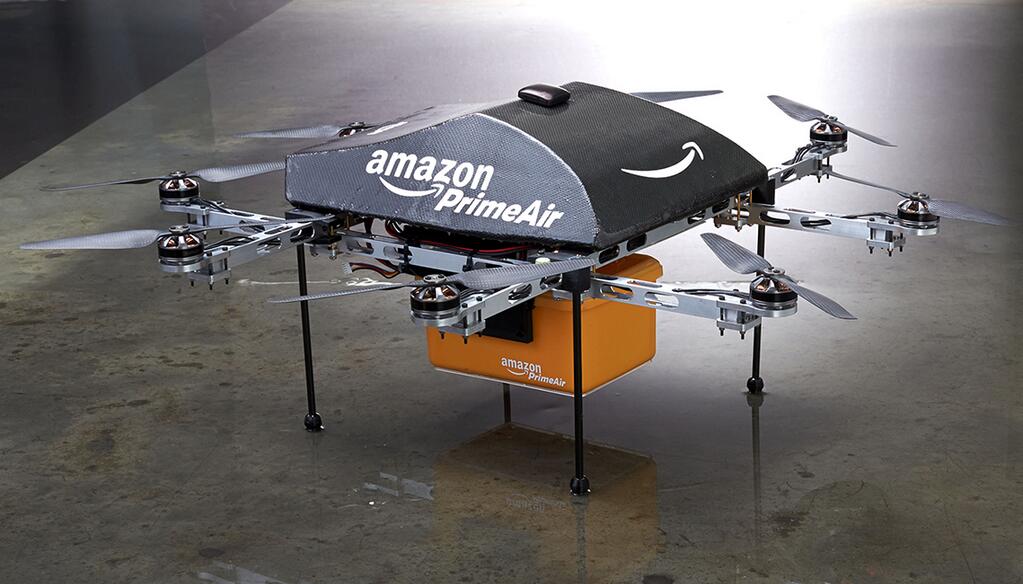The U.S. Army currently deploys drones that are used for security and surveillance purposes. Amazon, the world’s leading online retailer, has plans to commercialize the idea of the drone. Amazon CEO Jeff Bezos recently unveiled ‘Amazon Prime Air’, a service which uses unmanned aerial vehicles (UAVs) to deliver goods to customers. Drones buzzing above our heads rapidly delivering packages seems like a great idea, but one must also acknowledge certain drawbacks in design.

The eight-rotor Octocopter
The drone itself, called ‘Octocopter’, is not the most pretty looking. Charlie Rose, a correspondent of CBS News, described the drones as “giant, flying tarantulas”. From the image above, you can see why the drone has acquired the name ‘Octocopter’. Propelled by eight small rotors, the drone has a flying range of 10 miles. The device has parts that latch onto a yellow package box that contains the product. Despite its lack of aesthetics, the drone is ideal for its purpose: delivering goods.
The drone is designed to carry objects of up to 2.3 kilograms in weight. Since this weight covers “86% of the items” that Amazon delivers, the drone is a relevant technology for the company to implement. Amazon CEO Jeff Bezos stated in an interview that the drone can deliver “within 30 minutes of them (the customers) placing the order”. 30 minute deliveries represents a great convenience for the customer. If a customer is in an emergency and needs a product as quickly as possible, drones ensure fast delivery.

The drone departing the warehouse with a package
Combining the ability to deliver with high speed could result in significant boosts for Amazon and the country. Due to faster deliveries, the company’s efficiency and profit may increase. If other retailers implement drone delivery, the GDP of the U.S. could increase resulting in economic growth.

An airborne drone delivering a package
The convenience and efficiency of the Octocopter are counteracted by equally valid trade offs. Firstly, companies do not yet have permission to operate drones in civilian areas, as stated by the FAA (Federal Aviation Administration). It is estimated that civilian air space will be accessible “to all kinds of drones in the US by 2015”. Therefore, Amazon will have to wait it out for the green signal.
Secondly, there are substantial safety concerns associated with unmanned drones. According to Dr. Darren Ansell of the University of Central Lancashire, “UAVs do not currently have the awareness of their environment to be able to avoid flying into people”. Clearly, drones could collide with people while landing and injure them in the process. In cities and towns with large population densities, drones will be forced to fly at high altitudes. However, current rules do not allow this. Also, drones will be flying out in the open air and anyone can access them. By capturing or shooting down the drone, packages can be stolen or modified in transit. One must also consider that drones probably run on batteries. In the event that battery runs out while airborne, drones could drop ‘dead’ to the ground out of the sky. As silly as it sounds, it is a valid concern and Amazon must take measures to avoid this potential source of embarrassment.

An image portraying the serious issue of privacy in a comedic way
Thirdly, unmanned aerial vehicles flying over private homes is not an acceptable idea to some. People value their privacy and may not be comfortable with UAVs hovering above their heads. In some cases, there have been extreme reactions. In Deer Trail, Colorado, people are voting on “a $25 drone hunting license”. One individual who has acquired the license has clearly stated that he would “without hesitation, shoot down an Amazon Prime Air drone if it crossed his property”.
Amazon believes that in the future, “Prime Air vehicles will be as normal as seeing mail trucks on the road”. I want to take this opportunity to address the bigger picture by asking: is technological advancement always a good thing? In this context, consider how many jobs could be lost by replacing human manual labor with unmanned drones. Personally, I hope the human race achieves a balance between the inevitable march of technology and the livelihood of the average man.

The future of America?
References used:
http://www.wired.com/wiredscience/2013/12/physics-of-the-amazon-prime-air-drone/
http://www.bbc.co.uk/news/technology-25180906
http://www.denverpost.com/editorials/ci_24664142/amazons-drone-delivery-is-bold-idea
http://www.cbsnews.com/news/amazon-unveils-futuristic-plan-delivery-by-drone/
http://www.usatoday.com/story/tech/2013/12/05/drones-amazon-google-robots/3880409/

long blog on a great story. And you got a lot correct including the revolution in skeet shooting. Bezos was just getting free publicity for Amazon
This cannot work. Amazon and others just deliver far too many packages. These things may also be weaponized (and are by the military) and, even when not, used to spy on neighbors. But in remote areas they can deliver medicine see http://matternet.us/ They could be useful in search and rescue also